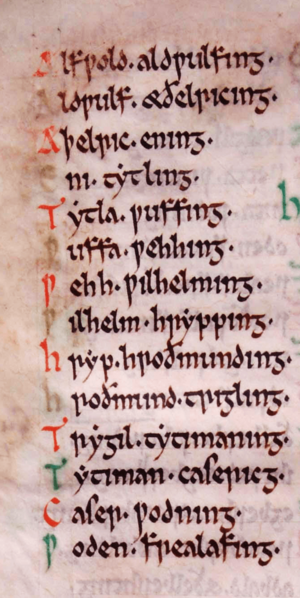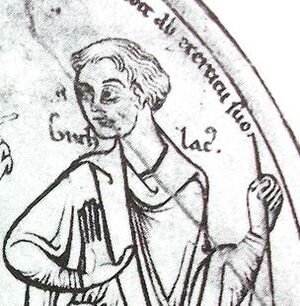Ælfwald of East Anglia facts for kids
Quick facts for kids Ælfwald |
|
|---|---|

'Alfƿald Aldƿulfing', as recorded (at the top of this list) in the Anglian collection
|
|
| King of the East Angles | |
| Reign | 713–749 |
| Predecessor | Ealdwulf |
| Successor | Beonna and Alberht and possibly Hun |
| Died | 749 |
| Dynasty | Wuffingas |
| Father | Ealdwulf |
| Religion | Christian |
Ælfwald (reigned from 713 to 749) was an important king of East Anglia. This was an Anglo-Saxon kingdom in what is now Norfolk and Suffolk, England. He was the last king from the Wuffingas family.
Ælfwald became king after his father, Ealdwulf, who ruled for a very long time. Ælfwald himself ruled for 36 years. Their reigns were mostly peaceful. There were not many wars or family fights. This brought a long period of calm to East Anglia.
During Ælfwald's time, East Anglia was stable for several reasons. The church was well-organized. Also, trade with places like the Rhineland brought wealth. This trade happened through the port of Gipeswic, which is now Ipswich. More Anglo-Saxon coins, called sceattas, were made during his rule. Finding many of these coins shows that East Anglia had busy mints, markets, and industries.
Ælfwald was friendly with Æthelbald of Mercia, a powerful king nearby. This helped keep peace between their kingdoms. A famous book called the Life of Guthlac was written for Ælfwald. It shows how good the writing was in East Anglia back then. Ælfwald was a Christian king who could read and write. A letter he wrote to Boniface around 747 shows his skill in dealing with others.
Contents
Ælfwald's Time as King
How Ælfwald Became King
Ælfwald became king in 713. At that time, the kingdom of Mercia was very strong. It controlled other areas like Lindsey and Essex. Ælfwald's sister, Ecgburgh, might have been an abbess (a leader of nuns) at Repton. This shows that Ælfwald likely grew up in a Christian home.
The Story of Guthlac
The Mercian king before Æthelbald, named Ceolred, had taken money from churches. This made many people in Mercia unhappy. He also treated his cousin, Æthelbald, badly. Æthelbald had to hide in a swampy area called Crowland. There, he met Saint Guthlac, a holy man living as a hermit.
When Guthlac died in 714, Ælfwald's sister, Ecgburgh, helped bury him. King Ceolred died soon after. Then, Æthelbald became the new king of Mercia. He ruled until 757 and made Mercia very powerful. Æthelbald remembered Guthlac. He built a rich new church where Guthlac had lived.
A monk named Felix wrote the first Life of Guthlac. He wrote it for King Ælfwald. This book tells about Æthelbald's time hiding at Crowland. It also supports Ælfwald's right to rule East Anglia. Later poems based on this book show how strong the writing was in Ælfwald's kingdom. Some historians even think the famous poem Beowulf might have come from East Anglia during Ælfwald's reign.
Important Church Leaders
During Ælfwald's rule, there were important bishops in East Anglia. Bishops were leaders of the church. They helped guide the people and the king in religious matters.
One bishop, Cuthwine, was known to have traveled to Rome. He brought back many beautiful illuminated manuscripts (hand-written books with pictures). These books were important for learning and religion.
The Growth of Ipswich Port
Ipswich was the first town built by the Anglo-Saxons in East Anglia. It was created a hundred years before other towns like Norwich. During Ælfwald's reign, Ipswich grew a lot. It became a large town of about 50 hectares (123 acres). It was known as Gipeswic back then.
Gipeswic was the main trading city for Ælfwald's kingdom. The king likely supported its growth. The town had a planned layout of streets near the quayside (where ships docked). This layout was similar to a big trading port in Europe called Dorestad.
Ipswich also became famous for its pottery. This pottery, called 'Ipswich ware', was very important around this time.
Coins of Ælfwald's Time
The coins made during Ælfwald's rule are some of the earliest from East Anglia. More silver coins, called sceattas, were made. Many types of these coins are thought to have been made in East Anglia.
These coins usually fall into two main groups, called 'Q' and 'R' series. They do not have the king's name on them. The 'Q' series coins are found mostly in western East Anglia. The 'R' series coins, which show a face and a symbol, are found more in central and eastern East Anglia, including the Ipswich area. Historians believe the 'R' series was made in Gipeswic (Ipswich).
A Letter to Boniface
A letter from King Ælfwald to Boniface, a leader of English missionaries in Europe, still exists. It was written between 742 and 749. This letter is one of the few documents that tell us about the church in East Anglia during this time.
The letter shows that Ælfwald understood Latin well. He wrote it to answer Boniface, who had asked for his help. Ælfwald told Boniface that the people of East Anglia remembered him in their prayers. He also offered to exchange lists of their dead. This way, they could pray for each other's loved ones.
Historians have studied a phrase in the letter. It talks about "seven monasteries." Some thought this meant there were seven monasteries in Ælfwald's kingdom. But others believe it means the monks prayed seven times a day, not that there were seven buildings.
Death
Ælfwald died in 749. We do not know if he had a direct heir to take his place. After his death, old records say that East Anglia was divided among three kings. The reasons for this are not clear.



